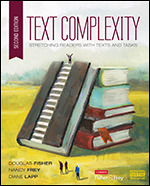
Text Complexity
Stretching Readers With Texts and Tasks
- Douglas Fisher - San Diego State University, USA
- Nancy Frey - San Diego State University, USA
- Diane Lapp - San Diego State University, USA
A Joint Publication of Corwin and the International Literacy Association
Corwin Literacy
Elementary Reading Methods
“There is a big difference between assigning complex texts and teaching complex texts…”
---Doug, Fisher, Nancy Frey, and Diane Lapp
….And that’s the crux, isn’t it? That’s why in this brand new edition of the bestselling Text Complexity, the renowned author team provide four new chapters that lay open the instructional routines that take students to new places as readers.
No matter what discipline you teach, you will learn how to craft purposeful instruction pitched to your readers’ comprehension capacities, your curriculum’s themes, and your own assessments on what students need next.
Doug, Nancy, and Diane provide:
- How-to’s for measuring word and sentence length and other countable features of any written work while giving ample consideration to the readers in your room, and how their background knowledge, experiences, and motivations come into play
- A rubric for analyzing literary texts for plot structure, point of view, imagery, clarity, and more—and a complexity scale for analyzing informational texts that describe, inform, and explain
- Classroom scenarios of teachers and students engaging with fiction and nonfiction texts that provide enough of a stretch, so you’ll know the difference between a healthy struggle and frustration
- The authors’ latest thinking on routines that invite students to interact with complex texts and with one another, including teacher modeling, close reading, scaffolded small group reading, and independent reading
It’s time to see text complexity as a dynamic, powerful tool for sliding the right text in front of our students’ at just the right time. Think of this second edition as Text Complexity-2-Go, because it’s all about the movement of minds at work, going deeper than anyone ever thought possible.
"Readers will explore text complexity and all its various parts: quantitative measures, qualitative values of literary texts, and qualitative aspects of informational texts. While reading the first four chapters, I was reminded of our responsibilities for designing and planning instruction. As a result, my copy is filled with stars, asterisks, and sticky notes. . . . In Chapters 5–9, teachers will find a wide range of tasks designed to help students read complex texts with competence and confidence. I thought Chapter 8, Exploring Peer-Led Tasks, was my favorite chapter until I got to Chapter 9, Exploring Individual Tasks. Then it was a toss-up!. . . This second edition, co-published with the International Literacy Association, will “stretch” both teachers and students!"
Students in my Content Reading are using this book for reference, discussion, and documentation. They have found it invaluable; I concur.
